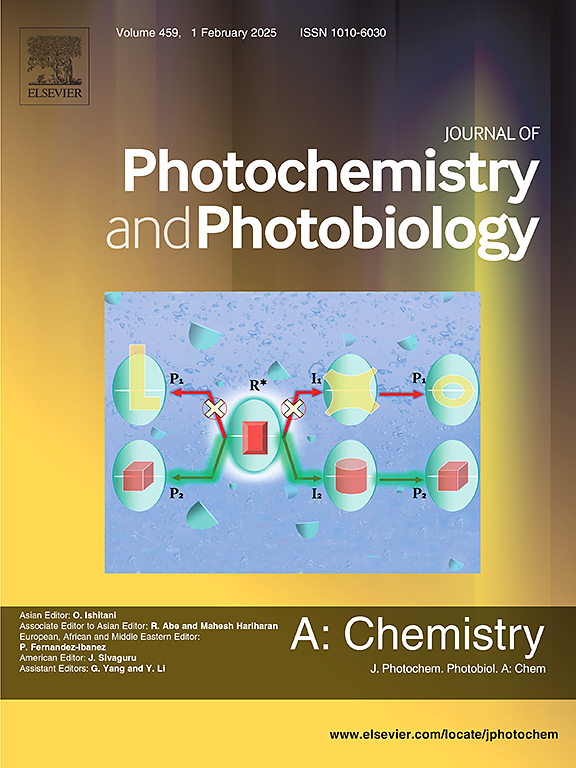Covalent bonded Bi4Ti3O12/covalent organic frameworks inorganic/organic heterojunctions for robust cocatalyst-free photocatalytic hydrogen production
IF 4.7
3区 化学
Q2 CHEMISTRY, PHYSICAL
Journal of Photochemistry and Photobiology A-chemistry
Pub Date : 2025-06-07
DOI:10.1016/j.jphotochem.2025.116560
引用次数: 0
Abstract
The high cost of noble metal cocatalysts is impractical for the practical application of photocatalytic hydrogen production. Therefore, the development of photocatalysts to achieve hydrogen production under cocatalyst-free conditions has important economical value. In this work, an excellent visible light responsive covalent organic framework (TpPa-1-COF) and Bi4Ti3O12 (BTO) are covalently bonded to construct BTO/TpPa-1-COF inorganic/organic heterojunctions. The obtained BTO/40 %TpPa-1-COF heterojunction achieves high photocatalytic activity without adding cocatalyst. The optimal photocatalytic hydrogen production rate is up to 1055 μmol/g/h, which is 24.3 and 6.2 times higher than that of TpPa-1-COF and physically mixed BTO-40 %TpPa-1-COF. Further studies confirm that the covalent connection between BTO and TpPa-1-COF components can greatly improve the photogenerated charge transfer of TpPa-1-COF, resulting in efficient hydrogen production activity. This provides a new perspective for promoting the practical application of efficient photocatalytic applications.

共价键Bi4Ti3O12/共价有机框架无机/有机异质结用于无共催化剂光催化制氢
贵金属助催化剂成本高,不利于光催化制氢的实际应用。因此,开发光催化剂实现无助催化剂条件下的制氢具有重要的经济价值。在这项工作中,一个优秀的可见光响应共价有机框架(TpPa-1-COF)和Bi4Ti3O12 (BTO)共价结合构建了BTO/TpPa-1-COF无机/有机异质结。得到的BTO/ 40% TpPa-1-COF异质结在不添加助催化剂的情况下具有较高的光催化活性。最佳光催化产氢速率可达1055 μmol/g/h,分别是TpPa-1-COF和物理混合bto - 40% TpPa-1-COF的24.3倍和6.2倍。进一步的研究证实,BTO与TpPa-1-COF组分之间的共价连接可以极大地提高TpPa-1-COF的光生电荷转移,从而产生高效的产氢活性。这为促进高效光催化的实际应用提供了新的视角。
本文章由计算机程序翻译,如有差异,请以英文原文为准。
求助全文
约1分钟内获得全文
求助全文
来源期刊
CiteScore
7.90
自引率
7.00%
发文量
580
审稿时长
48 days
期刊介绍:
JPPA publishes the results of fundamental studies on all aspects of chemical phenomena induced by interactions between light and molecules/matter of all kinds.
All systems capable of being described at the molecular or integrated multimolecular level are appropriate for the journal. This includes all molecular chemical species as well as biomolecular, supramolecular, polymer and other macromolecular systems, as well as solid state photochemistry. In addition, the journal publishes studies of semiconductor and other photoactive organic and inorganic materials, photocatalysis (organic, inorganic, supramolecular and superconductor).
The scope includes condensed and gas phase photochemistry, as well as synchrotron radiation chemistry. A broad range of processes and techniques in photochemistry are covered such as light induced energy, electron and proton transfer; nonlinear photochemical behavior; mechanistic investigation of photochemical reactions and identification of the products of photochemical reactions; quantum yield determinations and measurements of rate constants for primary and secondary photochemical processes; steady-state and time-resolved emission, ultrafast spectroscopic methods, single molecule spectroscopy, time resolved X-ray diffraction, luminescence microscopy, and scattering spectroscopy applied to photochemistry. Papers in emerging and applied areas such as luminescent sensors, electroluminescence, solar energy conversion, atmospheric photochemistry, environmental remediation, and related photocatalytic chemistry are also welcome.

 求助内容:
求助内容: 应助结果提醒方式:
应助结果提醒方式:


